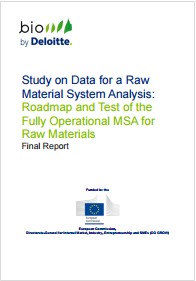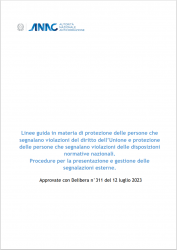Study on Data for a Raw Material System Analysis (SMA)
| ID 2470 | | Visite: 9392 | News Consumers | Permalink: https://www.certifico.com/id/2470 |
Study on Data for a Raw Material System Analysis (SMA)
Roadmap and Test of the Fully Operational MSA for Raw Materials Final Report
Whereas the supply security of fossil fuels has raised concerns among politicians and economic actors for many years, it is only recently that the growing challenge of securing access to metals and minerals needed for economic production has received the same public attention.
Indeed, many non-energy raw materials are not only essential for the production of a broad range of goods and applications used in everyday life, but also for the development of high tech products and emerging innovations, which are notably necessary for the development of more eco-efficient technologies.
However, very little primary production of these materials occurs within Europe and production of many materials is reliant on a few Third countries, creating a status of dependence on extra-EU supply for Europe and risks of market distortions.
To address this growing concern, the European Commission launched the European Raw Materials Initiative in 2008 and adopted in 2011 a strategy document which sets out targeted measures to secure and improve access to raw materials for the EU, based on a three-pillar approach:
- fair and sustainable supply of raw materials from international markets,
- fostering sustainable supply within the EU,
- boosting resource efficiency and promoting recycling.
These initiatives are part of the Europe 2020 strategy for smart, sustainable and inclusive growth and linked to the 'Innovation Union' flagship initiative, proposed by the European Commission in 2010. This global strategy recognises the importance of an effective innovation policy which covers innovation along the entire supply chain as well as the demand side, including in particular extraction, processing and recycling steps and tackling issues such as eco-design, substitution and resource efficiency. Nevertheless, for the successful implementation of EU policies in this field, there is a need of:
- identifying the raw materials that are key for the European Economy,
- and having a detailed picture of the flows of these materials in Europe. This knowledge would help identifying where innovation has the greatest potential, where it should be supported, and what the main leverages are. Within this context, the European Commission launched in 2010 the Study on Critical Raw Materials at the EU level in order to identify the non-energy raw materials considered as critical for Europe, based on their economic importance and their risk of supply interruption.
The first edition of this study in 2010 resulted in a list of 14 raw materials.
Then, a revision of this study in 2014 resulted in the current list of materials considered as critical for Europe, which includes 20 materials such as: antimony, beryllium, fluorspar, indium, rare earths… In parallel to these studies aiming at identifying key materials for Europe's economy, the European Commission launched in 2012 the Study on Data Needs for a Full Raw Materials Flow Analysis.
The objective of this study was to support the European Commission in identifying the information and data needs for a complete raw materials flow analysis at the European level. In particular, the aims of the study were to assess available data with reference to material flows, to examine data gaps and bottlenecks and to make recommendations for a future data strategy covering both the improvement of data availability and quality.
The study focused on information collection for 21 materials or groups of materials from a range of publicly available data bases, public authorities in each Member State, industry associations, companies and commercially available reports. The study pointed out data gaps regarding practically all stages of the life cycle of materials and identified as the main shortcomings the reliance on one-off or non-EU sources with no or irregular updates, the lack of standardized data and some insufficient details in the COMEXT trade statistics. The study also gave recommendations on how to overcome some of these gaps.
Thus, this study underlined the lack and the need of reliable data relating to flows and trends of critical raw materials in the EU. Indeed, a comprehensive data inventory of the materials flows in industry and society would be essential to get the solid ground for informed discussion and decision making on supply of raw materials. Such data on the quantity and quality of raw materials in each life cycle stage would allow more decisions that provide balanced, secure and sustainable supply throughout the entire materials flows.
EU 2016
Tags: News























